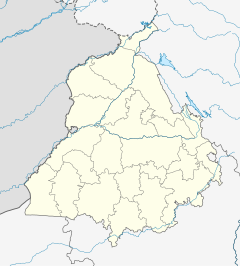
Back Amritsar-slagting Afrikaans مذبحة أمريتسار Arabic জালিয়ানৱালাবাগৰ হত্যাকাণ্ড Assamese Amritsar qırğını Azerbaijani জালিয়ানওয়ালাবাগ হত্যাকাণ্ড Bengali/Bangla Lazhadeg Amritsar Breton Massacre d'Amritsar Catalan Masakr v Amritsaru Czech Cyflafan Jallianwala Bagh Welsh Massaker von Amritsar German
| Jallianwala Bagh Massacre | |
|---|---|
 Martyr's memorial in Jallianwala Bagh | |
Location of Amritsar in Punjab | |
| Location | Amritsar, Punjab, British India (present-day Punjab, India) |
| Coordinates | 31°37′14″N 74°52′50″E / 31.62056°N 74.88056°E |
| Date | 13 April 1919 Evening |
| Target | Crowd of nonviolent protesters, along with Baisakhi pilgrims, who had gathered in Jallianwala Bagh, Amritsar |
Attack type | Massacre |
| Weapons | Lee-Enfield rifles |
| Deaths | 379[1] – 1,500[2] [3] |
| Injured | ~ 1,500[2] |
| Perpetrators | British Indian Army
|
The Jallianwala Bagh massacre, also known as the Amritsar massacre, took place on 13 April 1919. A large crowd had gathered at the Jallianwala Bagh in Amritsar, Punjab, British India, during the annual Baisakhi fair to protest against the Rowlatt Act and the arrest of pro-Indian independence activists Saifuddin Kitchlew and Satyapal. In response to the public gathering, the temporary brigadier general R. E. H. Dyer surrounded the people with his Gurkha and Sikh infantry regiments of the British Indian Army.[7][8][a] The Jallianwala Bagh could only be exited on one side, as its other three sides were enclosed by buildings. After blocking the exit with his troops, Dyer ordered them to shoot at the crowd, continuing to fire even as the protestors tried to flee. The troops kept on firing until their ammunition was low and they were ordered to stop.[9][10] Estimates of those killed vary from 379 to 1,500 or more people;[1] over 1,200 others were injured, of whom 192 sustained serious injuries.[11][12] Britain has never formally apologised for the massacre but expressed "deep regret" in 2019.[13]
The massacre caused a re-evaluation by the Imperial British military of its role when confronted with civilians to use "minimal force whenever possible" (although the British Army was not directly involved in the massacre; the British Indian Army was a separate organisation). However, in the light of later British military actions during the Mau Mau rebellion in the Kenya Colony, historian Huw Bennett has pointed out that this new policy was not always followed.[14] The army was retrained with less violent tactics for crowd control.[15]
The level of casual brutality and the lack of any accountability stunned the entire nation,[16] resulting in a wrenching loss of faith of the general Indian public in the intentions of the United Kingdom.[17] The attack was condemned by the Secretary of State for War, Winston Churchill, as "unutterably monstrous", and in the UK House of Commons debate on 8 July 1920 Members of Parliament voted 247 to 37 against Dyer. The ineffective inquiry, together with the initial accolades for Dyer, fuelled great widespread anger against the British among the Indian populace, leading to the non-cooperation movement of 1920–22.[18] Some historians consider the episode a decisive step towards the end of British rule in India.[19]
- ^ a b Nigel Collett (2006). The Butcher of Amritsar: General Reginald Dyer. A&C Black. p. 263. ISBN 978-1-85285-575-8.
- ^ a b Cite error: The named reference
encartawas invoked but never defined (see the help page). - ^ Narain, Savita (19 October 2013). The Jallianwala Bagh Massacre. Lancer Publishers LLC. ISBN 978-1-935501-87-9.
- ^ "No. 29509". The London Gazette (Supplement). 14 March 1916. p. 2902.
- ^ Misra, Maria (1 January 2008). Vishnu's Crowded Temple: India Since the Great Rebellion. Yale University Press. p. 150. ISBN 978-0-300-14523-6.
- ^ Sayer, Derek (6 September 2022). Crossing Cultures: Essays in the Displacement of Western Civilization. University of Arizona Press. p. 142. ISBN 978-0-8165-5131-6.
- ^ Misra, Maria (1 January 2008). Vishnu's Crowded Temple: India Since the Great Rebellion. Yale University Press. p. 150. ISBN 978-0-300-14523-6.
- ^ Sayer, Derek (6 September 2022). Crossing Cultures: Essays in the Displacement of Western Civilization. University of Arizona Press. p. 142. ISBN 978-0-8165-5131-6.
- ^ Nigel Collett (2006). The Butcher of Amritsar: General Reginald Dyer. A&C Black. p. 261. ISBN 978-1-85285-575-8.
- ^ "Jallianwala-Bagh-Massacre". Britannica. 4 December 2023.
- ^ Cite error: The named reference
Hunterwas invoked but never defined (see the help page). - ^ Dolly, Sequeria (2021). Total History & Civics 10 ICSE. New Delhi: Morning Star. p. 71.
- ^ "Amritsar: Theresa May describes 1919 massacre as 'shameful scar' – BBC News". BBC News. 10 April 2019. Retrieved 6 November 2021.
- ^ Bennett, Huw (2013). Fighting the Mau Mau: The British Army and Counter-Insurgency in the Kenya Emergency. Cambridge University Press.
- ^ Srinath Raghaven, "Protecting the Raj: The Army in India and Internal Security, c. 1919–39", Small Wars and Insurgencies, (Fall 2005), 16#3 pp 253–279 online
- ^ Bipan Chandra et al, India's Struggle for Independence, Viking 1988, p. 166
- ^ Barbara D. Metcalf and Thomas R. Metcalf (2006). A concise history of modern India. Cambridge University Press. p. 169
- ^ Collett, Nigel (2006). The Butcher of Amritsar: General Reginald Dyer. pp. 398–399.
- ^ Bond, Brian (October 1963). "Amritsar 1919". History Today. Vol. 13, no. 10. pp. 666–676.
Cite error: There are <ref group=lower-alpha> tags or {{efn}} templates on this page, but the references will not show without a {{reflist|group=lower-alpha}} template or {{notelist}} template (see the help page).
